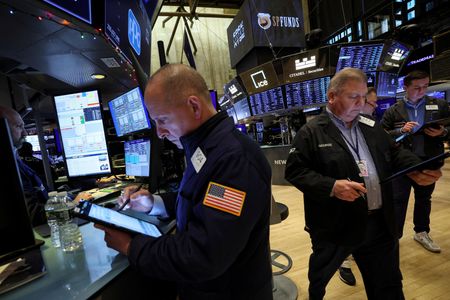By Mike Dolan
LONDON (Reuters) -Recession of some sort next year is fast becoming consensus – to such an extent that financial markets could find themselves whiplashed if it doesn’t materialise.
The gist of most 2023 outlooks is for a year of contracting activity at some point, disinflation and peaking interest rates. The investment upshot is a bias for bonds, a snubbing of the overvalued dollar and a volatile year for equities that will struggle to get much beyond current levels in 12 months.
Energy prices, Ukraine and China’s reopening remain the biggest wild cards. Although with cash holdings at their highest in well over a decade, the current tendency to push all the year’s beaten down assets a bit higher may endure through early next year.
So far, so straightforward.
But neither incoming hard economic numbers nor many senior policymakers have fully bought into the recession idea just yet.
And leaves investors mulling the chances of either the fabled “soft landing” – that somehow gets inflation back down without a major downturn – or some protracted scorched earth policy by central banks if persistent growth keeps price elevated.
Business surveys and historically prescient yield curve inversions in bond markets suggest contraction is now the best guess – even on a global level where sub-2% growth of the world economy is the equivalent of a recession.
Many economists now assume the euro zone and British economies – worst affected by the Ukraine-related energy shock and cost of living squeeze – are already in the throes of recession.
Yet this week’s upward revisions to U.S. third-quarter output, persistently tight labour markets there and the unshakeable assumption of a Chinese boomlet after a new year reopening from strict COVID lockdowns all speak otherwise.
Aside from Japan and emerging market indices, economic surprises for the major economies remain positive overall – suggesting excessive gloom in the forecasting world at least.
And it’s striking how many policymakers still think recession will be dodged.
CRASH AND CLEAN UP
Speaking to the Reuters Next conference on Thursday, IMF chief Kristalina Georgieva said the chances of a slowdown to sub-2% global growth were indeed rising – but she still only put a 1-in-4 chance of that actually happening.
And the IMF is far from alone.
Federal Reserve chief Jerome Powell on Wednesday insisted that a U.S. “soft or softish” landing remained possible, with inflation easing without a dramatic rise in unemployment.
In comments that lifted world markets – something that itself is an indirect softening of financial conditions supporting the economy – the chairman said the Fed didn’t want to “overtighten” just to “crash the economy and then clean up afterward.”
Powell’s more hawkish wing at the Fed is also sceptical of a recession narrative. St. Louis Fed President James Bullard on Monday said recession is not inevitable and suspected that expected disinflation was instead responsible for inverting the yield curve.
European Central Bank chief Christine Lagarde still speaks of euro zone growth weakening into next year – but not contraction.
And her hawkish wing also thinks recession fears are overcooked.
“If you look at Germany, where actually the economy is doing better than then was feared, it’s not a foregone conclusion that we will get a recession,” Dutch Central Bank chief Klaas Knot said on Monday in Paris, insisting weaker growth did not mean a downturn.
Many major investment houses, such as BlackRock, tend to disagree.
But not all think a soft landing is out of the question.
Goldman Sachs chief economist Jan Hatzius is one of the optimists.
“An extended period of below-potential growth can gradually reverse labor market overheating and bring down wage growth and ultimately inflation, providing a feasible if challenging path to a soft landing,” Hatzius said late last month.
All of which challenges the mounting consensus. And you would think avoiding recession should be cause for market cheer.
But there’s a massive difference to market positioning between a “soft landing” – ticking all boxes of disinflation and peak rates while avoiding a corporate earnings implosion – and persistent growth that buoys inflation and just forces central banks to slam harder on the brakes for years.
JP Morgan’s Bruce Kasman said his “baseline” is the lagged effect of Fed tightening does eventually drag the U.S. economy into recession late next year. But he also said it was a “mistake to rule out a soft landing scenario.”
However, he ascribed a 28% probability to a third scenario. That’s where growth persists into next year and is supported by central banks pausing rate rises in the first quarter – but inflation doesn’t come back into its comfort zone.
In that case, Kasman concluded: “With elevated inflation becoming embedded, policy rates will (then) need to rise materially further and a global recession takes hold in 2024.”
That may just be the nightmare 2023 scenario for markets.
The opinions expressed here are those of the author, a columnist for Reuters.
(by Mike Dolan, Twitter: @reutersMikeD; Editing by Lisa Shumaker)

